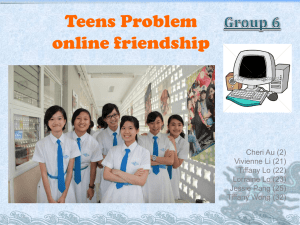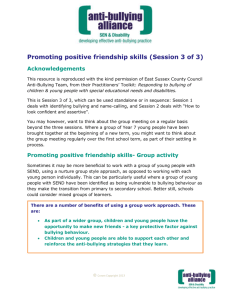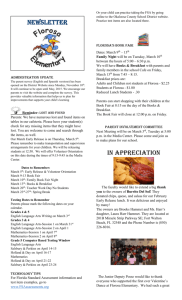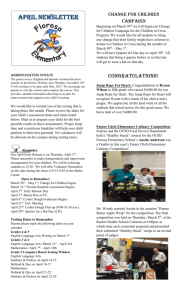Module goal sheet
advertisement
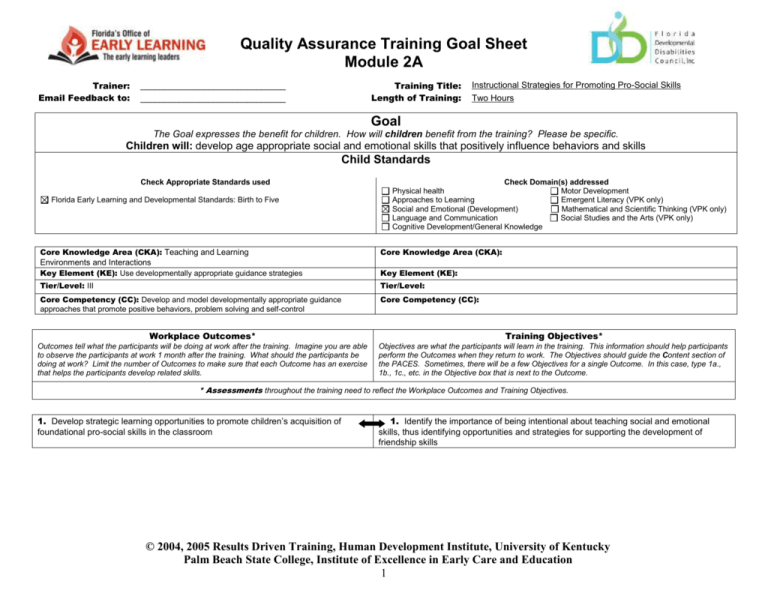
Quality Assurance Training Goal Sheet Module 2A Trainer: Email Feedback to: Training Title: Length of Training: ______________________________ ______________________________ Instructional Strategies for Promoting Pro-Social Skills Two Hours Goal The Goal expresses the benefit for children. How will children benefit from the training? Please be specific. Children will: develop age appropriate social and emotional skills that positively influence behaviors and skills Child Standards Check Appropriate Standards used Florida Early Learning and Developmental Standards: Birth to Five Core Knowledge Area (CKA): Teaching and Learning Check Domain(s) addressed Physical health Motor Development Approaches to Learning Emergent Literacy (VPK only) Social and Emotional (Development) Mathematical and Scientific Thinking (VPK only) Language and Communication Social Studies and the Arts (VPK only) Cognitive Development/General Knowledge Core Knowledge Area (CKA): Environments and Interactions Key Element (KE): Use developmentally appropriate guidance strategies Key Element (KE): Tier/Level: III Tier/Level: Core Competency (CC): Develop and model developmentally appropriate guidance approaches that promote positive behaviors, problem solving and self-control Core Competency (CC): Workplace Outcomes* Training Objectives* Outcomes tell what the participants will be doing at work after the training. Imagine you are able to observe the participants at work 1 month after the training. What should the participants be doing at work? Limit the number of Outcomes to make sure that each Outcome has an exercise that helps the participants develop related skills. Objectives are what the participants will learn in the training. This information should help participants perform the Outcomes when they return to work. The Objectives should guide the Content section of the PACES. Sometimes, there will be a few Objectives for a single Outcome. In this case, type 1a., 1b., 1c., etc. in the Objective box that is next to the Outcome. * Assessments throughout the training need to reflect the Workplace Outcomes and Training Objectives. 1. Develop strategic learning opportunities to promote children’s acquisition of foundational pro-social skills in the classroom 1. Identify the importance of being intentional about teaching social and emotional skills, thus identifying opportunities and strategies for supporting the development of friendship skills © 2004, 2005 Results Driven Training, Human Development Institute, University of Kentucky Palm Beach State College, Institute of Excellence in Early Care and Education 1 Quality Assurance Training Goal Sheet Module 2A Goal The Goal expresses the benefit for children. How will children benefit from the training? Please be specific. Children will: develop age appropriate social and emotional skills that positively influence behaviors and skills This form is for planning purposes and is particularly beneficial for new trainers. It is not required for initial submission. However, if the training is not approved, it will be required with the resubmitted material. OutcomeObjective #1 Content: State the key concepts that the participants will learn in the training. Remember that the content should help the participants develop the knowledge needed to perform the Outcomes when they return to work. 1. Teaching Social and Emotional Skills a. Why b. When c. What d. How *Twenty Minutes Exercise: Identify what opportunities there will be to practice skills that will be needed to perform the Outcome when participants return to work. The exercise should be authentic so they can use the skills in the real world. 1. Friendship & Pro-Social Skills a. Play Organizers – Participants provide RATIONALE b. Being Helpful – Participants DESCRIBE Skill c. Taking Turns – Participants will DEMONSTRATE d. Giving Compliments – Participants will develop a PRACTICE e. Knowing How to Apologize – Participants will develop ideas and model one to PROMOTE 2. Modeling examples – Which are you most likely to use and why? Develop a plan for using you preferred examples 3. Additional ideas – Participants share activities they have used *One hour Check for Understanding: How will you find out if the participants understand this key concept? 1. Embedding Friendship Opportunities Across the Daily Schedule Activity *Twenty Minutes Summary: What will you say to participants to review the key concepts related to this Outcome/Objective pair before you transition to the next Objective? Summarize by discussing how peer interactions and development of friendship skills are a great context for children to learn about regulating emotions. Think of all the issues that come up when children are playing (or attempting to play) together. They have many opportunities to practice organizing play situations, sharing, being helpful, taking turns, giving compliments, and apologizing! Friendships also foster children’s empathy skills, giving them opportunities to begin to understand other children’s feelings and perspectives. One way to help children be more successful in developing friendship skills is to “teach” them to label, understand, express, and control emotions. In the next session, we will discuss ideas for enhancing children’s emotional literacy. *Five minutes © 2004, 2005 Results Driven Training, Human Development Institute, University of Kentucky Palm Beach State College, Institute of Excellence in Early Care and Education 2

